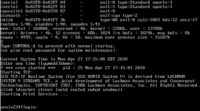XENIX
Xenix was Microsoft port of AT&T UNIX. Based on v6, v7, SYSIII, and later SYSV.
- XENIX was originally developed on a DEC Virtual Address Extension (VAX) running the Virtual Memory System (VMS) and a PDP-11 running UNIX V7, albeit now using Microsoft's own in-house minicomputers, and then converted into assembly language specific to the new 16-bit Motorola 68000 and Intel 8086 microprocessors. This put XENIX at the high end of the microcomputer market, which was still dominated by 8-bit machines, but well below the lowest end of the minicomputer market - "XENIX -- Microsoft Short-lived Love Affair with Unix "
Unfortinatly, "Xenix even incorporated the elements of BSD and became the most widely installed base of any Unix variant. Talking about the different modifications of Xenix, it was ported to Zilong Z8001, Intel 8086, Tandy Corporation’s 68000 based computers, and even a variant for Apple Lisa."
Modifications to Western Electric v7 included those necessary to transport the UNIX system from the larger PDP-11 mini computer to the 16-bit microprocessors. Currently scheduled machines included the DEC LSI-11/23, Zilogs Z8001 and Z8002, Intel's 8086 and 286, and Motorola's MC68000. - Robert Greenburg, uSloth.
Because of the price of the OS, about $500USD for the OS, and $500USD for the developer tools, combined with cheap PC and compatibles, Xenix was the most widespread UNIX until the rise of Linux. Xenix due to its inherent multi-user capabilities became widespread in sales environments with POS (Point of Sales) terminals, and for scheduling systems commonly found in hotels and restaurants. Occasionally you can still find this setup still running on aging hardware.
Xenix was a portable operating system with ports to various platforms, but with the rise of the IBM PC, it primarily became an x86 based OS. Xenix eventually became SCO Unix, then later SCO OpenServer, where it still languishes today.
Contents
Platforms
As mentioned in the OEM guide pdf, Xenix supported the following platforms:
- IBM 386 [386] The 32bit ones will run on Qemu/Virtual PC
- IBM PS/2 [386MC] This version was specifically for MCA computers with a 386 or higher CPU.
- IBM 286 [286] As is this version..*
- IBM PC [8088 or x86] This is 'easy' to find.
- A BYTE Magazine article reviews a MC68000 expansion card that runs Xenix from a complany called Sritek
- IBM System 9000 [M68000] [c19894]
- Apple Lisa [M68000] [c1984] The emulator idle can run this.
- Tandy TRS-80 Model II [Z80A] There are disk images floating around.
- PDP-11 No versions of this exist online.
- Zilog Z8001 [c1979] I have only found sales literature that mentions this.*
- Note: This sounds like vaporware since neither the Onyx 1 nor the Commodore 900 ran Xenix
More here: XENIX -- Microsoft Short-lived Love Affair with Unix
Software
A quick list of a few software programs that were available on Xenix. I know the x86 platform was the most supported, I now know that some of these made it to the less popular 68000 platform.
Microsoft
Microsoft made several of their programs in the 1980's available on the Xenix platform. Microsoft Multiplan, and the BASIC Compiler.
Languages
Applications
- Autodesk AutoCAD 10i
- Microsoft Multiplan (available on the Apple Lisa)
- Microsoft Word v5.0
- vi ( not really an application, but more of a torture device )
Databases
- Foxpro
Games
SCO*
- SCO Professional
- SCO Lyrix (available on the Apple Lisa)
- SCO Integra
- SCO Manager
- SCO Multiview
A history of Xenix: History Of Xenix - Microsoft's Forgotten Unix-based Operating System
Restoring Xenix 386 2.2.3c, Part 1
* - SCO in this case refers to the original Santa Cruz Operation, and not the later SCO Group who bought the name and started the SCO/Linux lawsuits.
Byte Magazine Article on Xenix June 1980, BYTE, pg 249
https://archive.org/details/byte-magazine-1981-06/page/n249
Emulators with ready to run distributions
- [x86] Architecture
http://www.hampa.ch/pce/download.html
- [i286] Architecture
Run Xenix in a browser window!
https://www.pcjs.org/disks/pcx86/unix/sco/xenix/086/2.1.3/
https://www.pcjs.org/disks/pcx86/unix/sco/xenix/286/2.1.3/ [ Currently does none of the 286 versions boot]
https://www.pcjs.org/disks/pcx86/unix/sco/xenix/386/
Getting this to run
- Note: The 286 version of Xenix will only run on a 286 processor or a 286 processor emulator that handles the upper byte of the machine status word, later reserved for use on a 386, by essentially ignoring it, and letting Xenix use it. A poor programming choice as best.
Available Xenix repositories:
https://github.com/retrohun/blog/tree/master/dt/xenix286ondemand
https://archive.org/details/msxenix/history/files/pics/progman5.jpg.~1~
https://winworldpc.com/product/xenix/286
Other Reference Pages
https://en.wikipedia.org/wiki/Xenix
http://www.edm2.com/index.php/XENIX
Extensive bibliography
| v • d • e UNIX Versions, Vendors and Related |
|---|
| Research Unix PDP-7 UNIX • V1 • V2 • V3 • V4 • V5 • V6 • V7 • V8 • V9 • V10 • LSX • MINI-UNIX • Unix/32V
AT&T - CB-UNIX • PWB/UNIX • USG UNIX • System III • System IV • System V BSD - 2.9 BSD • 2.10 BSD • 2.11 BSD • 3BSD • 4BSD • 4.1 BSD • 4.2 BSD • 4.3 BSD • 4.4 BSD BSD Descendants 386BSD • NetBSD • FreeBSD • OpenBSD • NeXTSTEP • Darwin |
| Other - xv6 • AMIX • SunOS • Solaris • ULTRIX • A/UX • XENIX • AIX • Dell UNIX |
